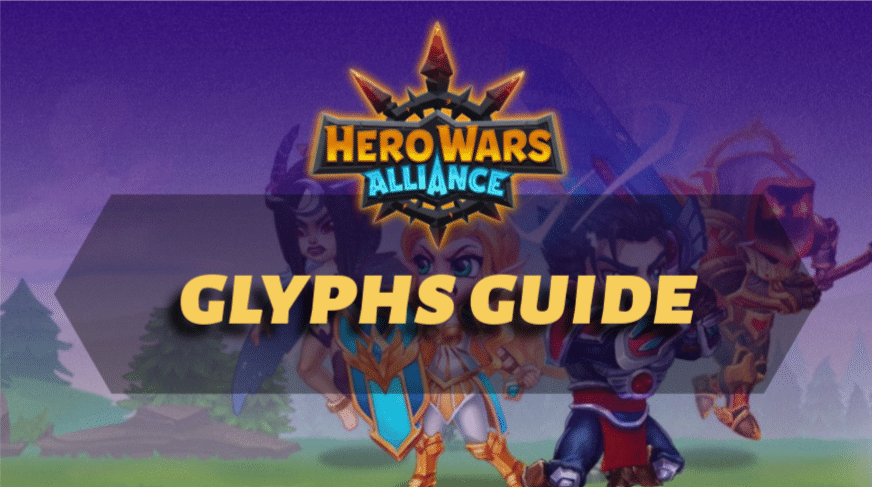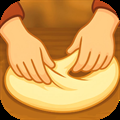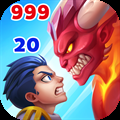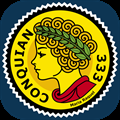
Introduction
Hero Wars Alliance Glyphs Guide will walk you through everything you need to know about Glyphs in Hero Wars Alliance!
Glyphs are a crucial element in Hero Wars Alliance, serving as the lifeblood of heroes by enhancing their stats and overall prowess on the battlefield. Each hero has five glyphs that can be upgraded to improve their capabilities. Each glyph boosts main or secondary stats, including Strength, Intelligence, Agility, Health, Physical attack, Magic attack, Armor, Magic defense, Critical hit chance, Dodge, Magic penetration, and Armor penetration. Leveling up glyphs is one of the primary ways to spend resources. However, it is important to only invest in heroes that are planned for long-term use.
Unlocking Glyphs
In Hero Wars Alliance, glyphs are progressively unlocked as a hero’s rank increases. Unlocking glyphs allows for the enhancement of a hero’s stats, increasing their effectiveness in battles. The specific ranks at which glyphs become available are as follows: The first two glyphs are unlocked when the hero reaches Blue rank. The third glyph is unlocked at Violet rank. The fourth glyph is unlocked at Violet +1 rank. The fifth glyph, which is always the hero’s primary stat, is unlocked at Violet +2 rank. Therefore, a hero needs to be at Violet +2 rank to have access to all five glyphs.
Leveling Up Glyphs
To enhance the benefits provided by glyphs in Hero Wars Alliance, players need to level them up. Leveling up glyphs requires resources such as Rune Stones or emeralds. Each glyph can be upgraded to a maximum level of 80. Rune Stones are the primary resource used for upgrading glyphs. These can be acquired through various means, including earning Guild activity points, completing daily quests, completing quests to enchant glyphs in the Quests tab, completing Hero’s Way tasks, the VIP Shop, the Grand Arena Shop, Heroic Chests, and purchasing special offers.
Small, Common, Rare, and Great Enchantment Runes have been converted into Runic Stones. Emeralds can also be used to speed up glyph leveling, but using emeralds for glyphs is one of the least efficient uses of emeralds in the game. It is crucial to only invest in heroes planned for long-term use. Avoid investing in heroes if you are unsure about their long-term viability in your team. Resource management is key in Hero Wars Alliance, so make sure you are spending wisely. The maximum level for each glyph was originally 40, but with the introduction of Runic Spheres, the maximum level cap was increased by 5 levels, up to a maximum of level 80.
Class Runes and Class Abilities
When all glyphs of a hero reach level 40, the Class Rune feature unlocks, granting the hero a class ability. This ability is a passive skill that all heroes of the same class share, and it works even for those heroes whose glyphs have not reached level 40 yet. To learn more about all class abilities, tap the “i” in the upper-left corner of the Glyphs tab.
To improve class abilities, players need to upgrade the Class Rune using Rune Spheres. These Spheres can be obtained by earning 55,000 total Guild activity points, completing tasks in special events, or purchasing special offers. Once enough Rune Spheres are collected, players can tap Improve in the Glyphs tab to upgrade the Class Rune. Upon upgrading, both the level and the stats of the class ability will increase for all heroes of that class. For example, upgrading Galahad’s Class Rune will improve the class ability for all warrior characters.
It is important to note that each hero needs to have their own Class Rune unlocked and upgraded separately. For example, unlocking Galahad’s Class Rune will not automatically make the Rune available to all other tanks, as each tank will still need to max out their glyphs first.
Level Cap Increase
Once you upgrade the Class Rune of a hero, the level cap of their Glyphs increases by five. To unlock the next upgrade of the Class Rune, you need to max out all Glyphs of this hero again. This can be done using Rune Stones or emeralds. After that, the level cap of their Glyphs will increase by five once again. This process continues until all Glyphs of the hero reach level 80.
Each hero of a class can contribute to the Class Rune upgrade nine times in total. When a hero’s Glyphs reach level 40, it corresponds to Class Rune level 1. When their Glyphs reach level 45, it corresponds to Class Rune level 2. Glyphs at level 50 correspond to Class Rune level 3. Glyphs at level 55 correspond to Class Rune level 4. Glyphs at level 60 correspond to Class Rune level 5. Glyphs at level 65 correspond to Class Rune level 6. Glyphs at level 70 correspond to Class Rune level 7. Glyphs at level 75 correspond to Class Rune level 8. Finally, when the hero’s Glyphs reach level 80, it corresponds to Class Rune level 9.
Glyph Leveling Strategies
When it comes to leveling glyphs, a strategic approach can significantly enhance a team’s effectiveness. New players should start with a balanced approach, evenly developing all glyphs up to a modest level, around level 20-25. This ensures heroes receive a well-rounded boost to their capabilities, with stats distributed evenly across the board.
As players progress, prioritizing glyphs based on a hero’s skills and primary attributes becomes essential. Enhancing a hero’s strengths while addressing their weaknesses will lead to a well-rounded combat prowess. To determine the importance of glyphs, it’s crucial to delve into the hero’s skill set. Many skills derive power from physical attack, magic attack, or health, so understanding this can help players prioritize the right upgrades.
For team-based strategies, leveling up a team for Guild Wars and Arena play is effective because it allows an understanding of a character’s strengths against other characters. Another strategy is maximizing glyphs on one character exclusively, which assures versatility and ensures that character will be useful in interserver battles or the grand arena. Additionally, leveling characters exclusively from a single class is ideal when focusing on class skill improvement. On the other hand, evenly leveling one character from each class minimizes risks against inevitable changes in the game’s dynamics.
In terms of versatility, players should prioritize key glyphs based on the hero’s skill set, considering whether their skills rely on physical attack, magic attack, or health. For damage dealers, prioritizing glyphs that enhance their ultimate skill is crucial, as it can be a game-changer during battles.
Regarding leveling style, some players prefer to focus on one glyph at a time, while others level all glyphs simultaneously. Each method has its benefits, depending on the desired outcome and available resources.
Finally, other considerations should also be taken into account. Developers are often aware of popular characters and may introduce counter-heroes to maintain balance in the game. Players should also be mindful that the control class skill may require the least investment but still offer the most impact. Additionally, the support tree may end up being the strongest option in certain scenarios, so it’s important to factor this in when planning glyph upgrades.
Class Abilities Details
In Hero Wars Alliance, heroes are categorized into different classes, each with unique abilities tailored to their roles on the battlefield. Understanding these abilities is crucial for forming effective teams and strategies. The classes are Tank, Warrior, Marksman, Mage, Healer, Support, and Control.
To access a class skill, you must improve all glyphs of any member of that class up to level 40 and pay 1,000 rune spheres. When you level a class skill, its level will change for all heroes of the class.
The Tank class has the ability to redirect incoming damage to themselves when an ally’s HP falls below a certain threshold for a limited duration. This effect can trigger once per ally every few seconds. Heroes in this class include Aurora, Chabba, Mushy & Shroom, Luther, Julius, Corvus, Astaroth, Cleaver, Ziri, and Rufus.
The Warrior class has an ability where each auto-attack increases the warrior’s physical attack for a short duration for every opponent hit, stacking up to a certain limit. Heroes in this class include Ninja Turtles, Elmir, Yasmine, Galahad, Ishmael, Qing Mao, Tristan, K’arkh, and Kayla.
The Marksman class has an ability where, when the target’s HP drops below a certain percentage, the marksman deals increased damage with their attacks for a brief period. This effect can trigger periodically. Heroes in this class include Lara Croft, Jhu, Dark Star, Artemis, Daredevil, Fox, Ginger, Astrid & Lucas, Keira, Dante, and Cascade.
The Mage class gains an initial boost of energy upon entering the battlefield and continues to gain additional energy with each spell cast. Heroes in this class include Folio, Kai, Mojo, Cornelius, Orion, Iris, Lilith, Lars, Xe’Sha, Heidi, and Satori.
The Healer class has an ability where, whenever healing or shielding effects are applied to an ally, incoming damage is converted into additional healing for a limited duration. This effect can activate periodically. Heroes in this class include Thea, Markus, Morrigan, Dorian, Aidan, Maya, and Martha.
The Support class has an ability where, whenever this hero applies a buff to an ally or damages enemy teams, opponents receive a debuff that reduces their Armor and Magic Defense for a certain duration. This effect can stack multiple times. Heroes in this class include Tempus, Soleil, Alvanor, Fafnir, Helios, Sebastian, Jet, Nebula, Amira, and Celeste.
The Control class has an ability that extends the duration of all crowd control effects such as Marks, Stun, Charm, Blind, and Silence for a certain duration. Heroes in this class include Isaac, Arachne, Judge, Phobos, Faceless, Peppy, Jorgen, Krista, Andvari, and Lian.
Prioritizing Class Glyphs
As you advance in Hero Wars Alliance, prioritizing the leveling of Class Glyphs is essential for maximizing your team’s potential. To strategically prioritize Class Glyphs, align them with your playstyle and the current meta of the game. Focus on leveling up Class Glyphs for classes that complement your preferred playstyle or the current game trends.
When planning a hero lineup, it’s important to consider the synergies between Class Abilities and your overall strategy. Warriors, for example, are objectively attractive due to their strong damage potential, with heroes like Galahad as a tank and powerful meta damage dealers and penetrators. Their aggressive potential is so high that they often don’t need a Healer or support hero.
There is now a clear advantage for Warriors, as they have extremely strong characters in their own class. It’s likely that the balance will be adjusted in the near future to ensure that other classes can compete effectively, allowing for a more versatile range of teams. By adhering to this strategy, you minimize risk because your characters cover all available classes in the game, remaining relevant in multiple team compositions.
Invest resources into Class Glyphs that enhance the strengths of your team composition to gain a significant edge in battles. Keep track of which heroes contribute to each Class Glyph and focus on leveling up the glyphs with the most impactful abilities for your strategy.
The control class skill may require the least investment but yield the most impact. Level up one control hero to level 45 glyphs. The effect can’t trigger on a single target more often than once every 10 seconds, with a damage reduction of 7200. Upon completion of the control action, it slows the target by 30% and reduces total physical damage for four seconds. This 30-second cooldown feels like a static number.
The support tree may ultimately prove to be the strongest one out of all the classes. On the other hand, the tank class skill may be less impactful depending on the tanks you choose, as you may not want to increase the magic defense on a hero like Rufus.
Keep experimenting with different hero combinations and Class Abilities to discover new synergies and optimize your team’s performance. Stay informed about updates and changes to the glyph system so you can adapt your strategies accordingly.
Examples of Hero Glyph Priorities
To effectively develop glyphs, it’s essential to understand how a hero’s skills scale with different stats. Here are some examples of hero glyph priorities:
General Guidance: Scrutinize a hero’s skills to determine whether they rely on magic damage, physical attack, or health. Then, construct a glyph development plan that aligns with the hero’s strengths and weaknesses.
Aurora: Her primary glyph should focus on magic attack, as three of her abilities rely on it. The secondary glyph should prioritize strength, which fortifies her health and supports the Health Glyph and Dodge. Prioritizing dodge above all else may lead to a dilemma, as without enhancing her damage-dealing capabilities, her dodges remain evasive maneuvers without impactful retaliation.
Dante: All four of Dante’s abilities are rooted in physical attack, scaling up in potency with the enhancement of his physical attack stat. His foremost priority should be agility, as a hero’s main stats are intricately linked to their skills. His next priority should be armor penetration, followed by a lower priority for armor, as Dante’s survivability depends more on his agility and dodge rather than fortifying his armor.
Polaris: Polaris’s white skill, Pulsing Comet, draws strength from her magic attack, while her green skill, Glacial Fortress, relies on her health. However, her most formidable abilities, Northern Lights and True Freeze, are not based on Polaris’s inherent stats but are instead determined by her skill level. Therefore, her glyph priorities should focus on survivability, particularly health and armor.
Individual Hero Glyph Priorities: For each hero, there are different glyph priorities depending on their strengths. For example, Aidan’s primary glyphs should focus on health, magic attack, intelligence, armor, and magic defense. Alvanor should prioritize health, magic attack, intelligence, magic penetration, and magic defense. Amira should focus on health, magic penetration, magic attack, armor, and intelligence. Andvari should prioritize health, strength, armor penetration, physical attack, and armor. Other heroes like Arachne, Artemis, Astaroth, and Astrid & Lucas have their own specific glyph needs, whether they are focused on magic penetration, armor, physical attack, agility, or other stats.
For example, Dante requires health, dodge, physical attack, agility, and armor, while heroes like Jorgen and Judge may require a combination of magic attack, magic defense, armor, strength, and health. In the case of Jhu, his glyph priorities would focus on armor penetration, critical hit chance, physical attack, strength, and health. Similarly, heroes like Keira, Lian, Lilith, and Luther require their glyphs to focus on different combinations of health, armor, magic defense, and physical or magic attack to maximize their effectiveness.
Each hero’s unique abilities, whether they scale with magic, physical, or health stats, will dictate their ideal glyph development path. By aligning glyph priorities with these abilities, you can optimize your team’s performance in battle.
Resources for Glyphs
To level up glyphs and class runes, you’ll need to manage several resources. Here’s a breakdown of how to acquire them:
Rune Stones are the primary resource for leveling up glyphs. Small, Common, Rare, and Great Enchantment Runes have been converted into Runic Stones, which are now used for glyph upgrades. You can acquire Rune Stones through several methods: earning Guild activity points, with each Guild member receiving a daily reward based on total Guild activity points. The reward is sent to the in-game mail after your Guild reaches a certain threshold. You can also complete daily quests, such as “Earn 850/1500 Guild Activity points,” or complete quests to enchant Glyphs in the Quests tab. Additionally, Rune Stones can be acquired through Hero’s Way tasks, the VIP Shop, the Grand Arena Shop, Heroic Chests, and special offers.
Rune Spheres are required to increase the maximum cap of current glyphs by 5 levels, up to a maximum level cap of 80, and they are also necessary to upgrade the Class Rune. Rune Spheres can be obtained by earning 55,000 total Guild activity points, completing tasks in special events, purchasing special offers, or engaging in the upgraded Highwaymen mode in Outland, which features new Orange-grade opponents and higher rarity chests.
Emeralds can be used to speed up glyph leveling, although this is one of the least efficient uses of emeralds in the game. It’s generally better to spend emeralds on Outland chests or energy.
Gold is also required to level up glyphs, making it one of the biggest gold sinks in the game.
Conclusion
Glyph Class Skills and the enhancement of glyphs are pivotal in determining your success in Hero Wars Alliance. You should prioritize leveling glyphs and Class Glyphs that align with your play style, hero skills, and team composition. Efficiently managing Rune Stones, Rune Spheres, and gold is crucial to maximizing your heroes’ potential. Avoid inefficient uses of emeralds, such as speeding up glyph leveling. Stay informed about game updates and meta shifts to adapt your strategies and hero priorities accordingly.
Experiment with different hero combinations and Class Abilities to discover new synergies and optimize your team’s performance. Focus on investing in heroes you plan to use long term to make the most of your resources. By unlocking and maximizing the power of Class Abilities, you can gain a significant advantage over your opponents. Diversifying your hero pool to cover all available classes ensures you are well-equipped to handle any challenge.
By following this guide, you can strategically enhance your heroes, dominate the battlefield, and etch your name into the annals of legend in Hero Wars Alliance.













